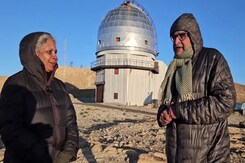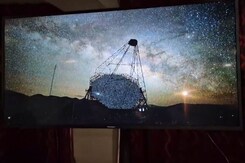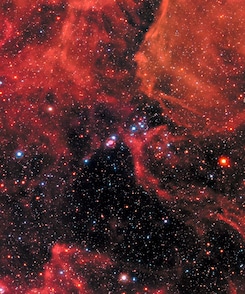Telescope
- All
- News
- Videos
- Web Stories
-

NASA’s SPHEREx Telescope Delivers First Full-Sky Map, Unlocking Cosmic Secrets
- Tuesday December 23, 2025
NASA’s SPHEREx telescope has completed its first all-sky map, revealing hundreds of millions of galaxies and providing data to study the universe’s origin, evolution, and distribution of life-essential elements across cosmic history.
-
 www.gadgets360.com
www.gadgets360.com
-

Betelgeuse and the Crab Nebula Reveal Stellar Death and Rebirth in Multi-Telescope Views
- Sunday December 21, 2025
Betelgeuse’s unusual dimming and the Crab Nebula’s remnants offer insight into stellar death and rebirth. Composite images from multiple telescopes show gas filaments and a neutron star, illustrating how massive stars explode, enrich space with heavy elements, and seed future star formation. These observations help scientists trace stellar life...
-
 www.gadgets360.com
www.gadgets360.com
-

Hubble Captures Gas Escaping Sideways Spiral Galaxy NGC 4388 in Virgo Cluster
- Sunday December 21, 2025
Hubble has captured a glowing plume of gas escaping the spiral galaxy NGC 4388 in the Virgo cluster. Moving through hot intracluster gas, the galaxy sheds material, partially energised by its central black hole. Multi-wavelength observations reveal the impact of both environmental forces and central activity on galaxy evolution.
-
 www.gadgets360.com
www.gadgets360.com
-

Hubble Captures Rare Collision in Nearby Planetary System, Revealing Violent Planet Formation
- Friday December 19, 2025
Astronomers using NASA’s Hubble Space Telescope have witnessed rare collisions between rocky bodies in the Fomalhaut system. The glowing debris clouds created by these impacts offer a unique glimpse into how planets form and highlight challenges in identifying true exoplanets.
-
 www.gadgets360.com
www.gadgets360.com
-

Interstellar Comet 3I/ATLAS to Make Closest Approach to Earth on December 19
- Thursday December 18, 2025
Interstellar comet 3I/ATLAS will make its closest approach to Earth on Dec. 19, passing safely at a vast distance. Discovered by NASA-funded telescopes, the rare visitor offers scientists a valuable chance to study material formed around another star. Observations from space telescopes are expected to deepen understanding of interstellar objects.
-
 www.gadgets360.com
www.gadgets360.com
-

James Webb Confirms First Runaway Supermassive Black Hole Rocking Through Space
- Thursday December 18, 2025
The James Webb Space Telescope has confirmed the first runaway supermassive black hole, moving at 2.2 million mph through the Cosmic Owl galaxies. Pushing a galaxy-sized shockwave and leaving a long trail of star-forming gas, this discovery confirms long-standing theories about black hole ejections and opens the door to finding more cosmic speedste...
-
 www.gadgets360.com
www.gadgets360.com
-

James Webb Space Telescope Could Illuminate Dark Matter in an Unexpected Way
- Thursday December 18, 2025
New research suggests the James Webb Space Telescope could help uncover the true nature of dark matter. By observing strange, elongated galaxies in the early universe, scientists believe JWST may reveal how dark matter shaped cosmic structure, offering clues that could narrow down long-standing theories about this invisible substance.
-
 www.gadgets360.com
www.gadgets360.com
-

James Webb Space Telescope Could Help Reveal Dark Matter in a Way Scientists Did Not Anticipate
- Wednesday December 17, 2025
New research suggests the James Webb Space Telescope could help scientists understand dark matter by studying oddly shaped early galaxies. These elongated galaxies may form due to dark matter’s gravitational behaviour, offering indirect clues about whether ultralight or warm dark matter particles shaped the early universe.
-
 www.gadgets360.com
www.gadgets360.com
-

Interstellar Comet 3I/ATLAS Nears Earth on Dec. 19, Offering Rare Insights Into Cosmic Visitors
- Wednesday December 17, 2025
Interstellar comet 3I/ATLAS will make its closest approach to Earth on Dec. 19. Observing the comet provides scientists a rare opportunity to study dust and gases from its icy nucleus and learn more about material forming around other stars, expanding understanding of interstellar objects while posing no threat to our planet.
-
 www.gadgets360.com
www.gadgets360.com
-

James Webb Telescope Finds Evidence Of Giant "Dinosaur" Stars From Early Universe
- Tuesday December 16, 2025
- Science |
The research also suggests that these massive stars transformed directly into black holes at the end of their lives without undergoing a supernova explosion.
-
 www.ndtv.com
www.ndtv.com
-

NASA's Roman Telescope Set To Map Cosmic Voids, Reveal Universe's Dark Energy Secrets
- Tuesday December 16, 2025
- Science |
The Roman telescope promises to provide a clearer picture of the large-scale structure of the universe and the forces shaping it, bringing scientists closer to understanding the cosmic puzzles of dark matter.
-
 www.ndtv.com
www.ndtv.com
-

Astronomers Witness Longest-Lasting Gamma-Ray Burst in History, 8 Billion Light-Years Away
- Tuesday December 16, 2025
A gamma-ray burst lasting over seven hours was recorded 8 billion light-years away, revealing a rare type of cosmic explosion and challenging current astrophysics models.
-
 www.gadgets360.com
www.gadgets360.com
-

Interstellar Comet 3I/ATLAS To Make Closest Flyby Of Earth On December 19
- Tuesday December 16, 2025
- Science |
Interstellar comet 3I/ATLAS, discovered by NASA-funded telescopes, will pass Earth on December 19 at a safe distance of 270 million km.
-
 www.ndtv.com
www.ndtv.com
-

NASA’s SPHEREx Telescope Delivers First Full-Sky Map, Unlocking Cosmic Secrets
- Tuesday December 23, 2025
NASA’s SPHEREx telescope has completed its first all-sky map, revealing hundreds of millions of galaxies and providing data to study the universe’s origin, evolution, and distribution of life-essential elements across cosmic history.
-
 www.gadgets360.com
www.gadgets360.com
-

Betelgeuse and the Crab Nebula Reveal Stellar Death and Rebirth in Multi-Telescope Views
- Sunday December 21, 2025
Betelgeuse’s unusual dimming and the Crab Nebula’s remnants offer insight into stellar death and rebirth. Composite images from multiple telescopes show gas filaments and a neutron star, illustrating how massive stars explode, enrich space with heavy elements, and seed future star formation. These observations help scientists trace stellar life...
-
 www.gadgets360.com
www.gadgets360.com
-

Hubble Captures Gas Escaping Sideways Spiral Galaxy NGC 4388 in Virgo Cluster
- Sunday December 21, 2025
Hubble has captured a glowing plume of gas escaping the spiral galaxy NGC 4388 in the Virgo cluster. Moving through hot intracluster gas, the galaxy sheds material, partially energised by its central black hole. Multi-wavelength observations reveal the impact of both environmental forces and central activity on galaxy evolution.
-
 www.gadgets360.com
www.gadgets360.com
-

Hubble Captures Rare Collision in Nearby Planetary System, Revealing Violent Planet Formation
- Friday December 19, 2025
Astronomers using NASA’s Hubble Space Telescope have witnessed rare collisions between rocky bodies in the Fomalhaut system. The glowing debris clouds created by these impacts offer a unique glimpse into how planets form and highlight challenges in identifying true exoplanets.
-
 www.gadgets360.com
www.gadgets360.com
-

Interstellar Comet 3I/ATLAS to Make Closest Approach to Earth on December 19
- Thursday December 18, 2025
Interstellar comet 3I/ATLAS will make its closest approach to Earth on Dec. 19, passing safely at a vast distance. Discovered by NASA-funded telescopes, the rare visitor offers scientists a valuable chance to study material formed around another star. Observations from space telescopes are expected to deepen understanding of interstellar objects.
-
 www.gadgets360.com
www.gadgets360.com
-

James Webb Confirms First Runaway Supermassive Black Hole Rocking Through Space
- Thursday December 18, 2025
The James Webb Space Telescope has confirmed the first runaway supermassive black hole, moving at 2.2 million mph through the Cosmic Owl galaxies. Pushing a galaxy-sized shockwave and leaving a long trail of star-forming gas, this discovery confirms long-standing theories about black hole ejections and opens the door to finding more cosmic speedste...
-
 www.gadgets360.com
www.gadgets360.com
-

James Webb Space Telescope Could Illuminate Dark Matter in an Unexpected Way
- Thursday December 18, 2025
New research suggests the James Webb Space Telescope could help uncover the true nature of dark matter. By observing strange, elongated galaxies in the early universe, scientists believe JWST may reveal how dark matter shaped cosmic structure, offering clues that could narrow down long-standing theories about this invisible substance.
-
 www.gadgets360.com
www.gadgets360.com
-

James Webb Space Telescope Could Help Reveal Dark Matter in a Way Scientists Did Not Anticipate
- Wednesday December 17, 2025
New research suggests the James Webb Space Telescope could help scientists understand dark matter by studying oddly shaped early galaxies. These elongated galaxies may form due to dark matter’s gravitational behaviour, offering indirect clues about whether ultralight or warm dark matter particles shaped the early universe.
-
 www.gadgets360.com
www.gadgets360.com
-

Interstellar Comet 3I/ATLAS Nears Earth on Dec. 19, Offering Rare Insights Into Cosmic Visitors
- Wednesday December 17, 2025
Interstellar comet 3I/ATLAS will make its closest approach to Earth on Dec. 19. Observing the comet provides scientists a rare opportunity to study dust and gases from its icy nucleus and learn more about material forming around other stars, expanding understanding of interstellar objects while posing no threat to our planet.
-
 www.gadgets360.com
www.gadgets360.com
-

James Webb Telescope Finds Evidence Of Giant "Dinosaur" Stars From Early Universe
- Tuesday December 16, 2025
- Science |
The research also suggests that these massive stars transformed directly into black holes at the end of their lives without undergoing a supernova explosion.
-
 www.ndtv.com
www.ndtv.com
-

NASA's Roman Telescope Set To Map Cosmic Voids, Reveal Universe's Dark Energy Secrets
- Tuesday December 16, 2025
- Science |
The Roman telescope promises to provide a clearer picture of the large-scale structure of the universe and the forces shaping it, bringing scientists closer to understanding the cosmic puzzles of dark matter.
-
 www.ndtv.com
www.ndtv.com
-

Astronomers Witness Longest-Lasting Gamma-Ray Burst in History, 8 Billion Light-Years Away
- Tuesday December 16, 2025
A gamma-ray burst lasting over seven hours was recorded 8 billion light-years away, revealing a rare type of cosmic explosion and challenging current astrophysics models.
-
 www.gadgets360.com
www.gadgets360.com
-

Interstellar Comet 3I/ATLAS To Make Closest Flyby Of Earth On December 19
- Tuesday December 16, 2025
- Science |
Interstellar comet 3I/ATLAS, discovered by NASA-funded telescopes, will pass Earth on December 19 at a safe distance of 270 million km.
-
 www.ndtv.com
www.ndtv.com























![Gadgets 360 With Technical Guruji: Did You Know? [April 6, 2024] Gadgets 360 With Technical Guruji: Did You Know? [April 6, 2024]](https://c.ndtvimg.com/2024-02/mpconh58_did-you-know_640x480_10_February_24.jpg?downsize=245:163)














